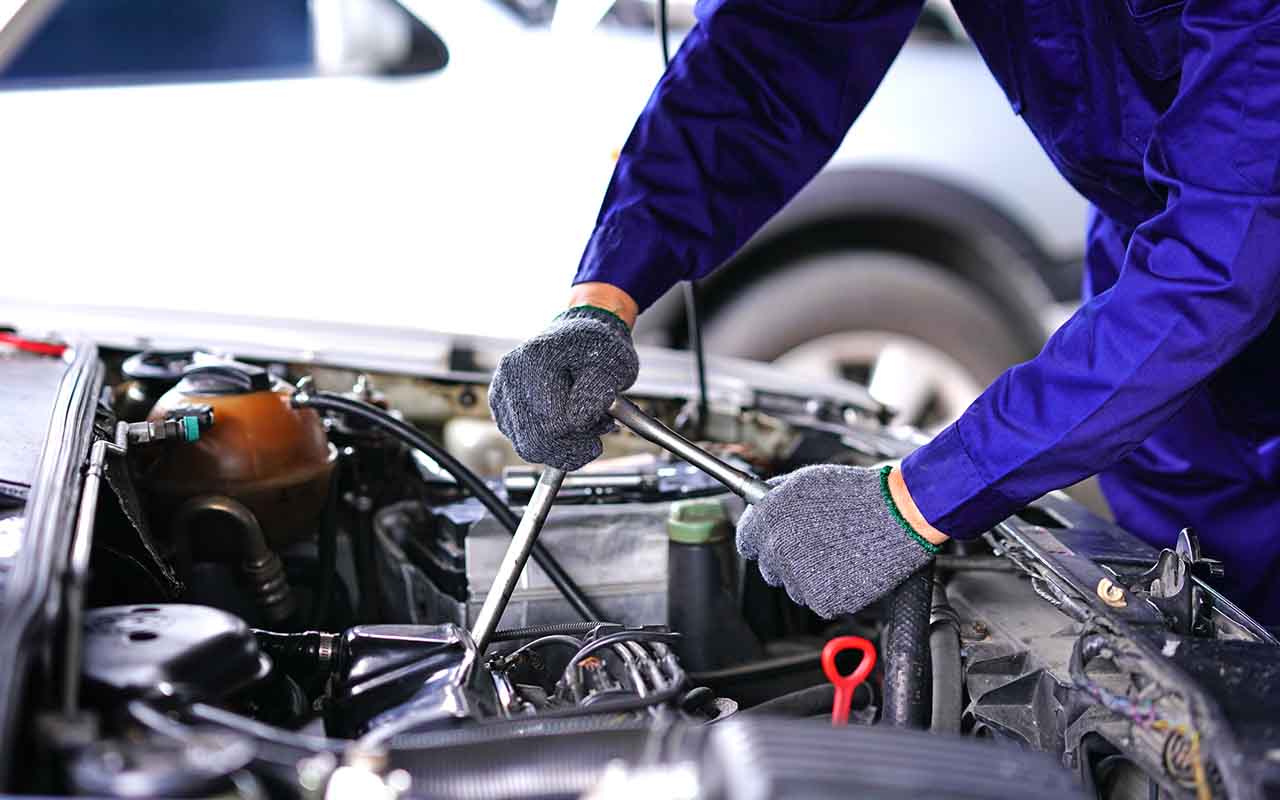
Car features have come a long way.
Gone are the days when you needed a buddy system or flexible giraffe neck to help see enough to wedge into or out of tight spaces. Now, vehicles do the work for you — and not just when it comes to parking.
The most encouraging car innovation trends continue to emphasize safety. From forward collision warning and pedestrian detection to lane-keeping assist and blind-spot monitoring, today's vehicles are more protective than ever before — and getting smarter every day.
These systems help drivers stay aware of their surroundings, prevent accidents and make driving less stressful. It's hard to imagine life before them — but it also makes us wonder: What else are we soon going to be taking for granted?
Here are five futuristic car technologies that are no longer reserved for luxury models and are becoming increasingly common on the road today.
1. Self-driving car technology
The concept of self-driving cars goes back to the 1920s. Former U.S. Army electrical engineer Francis P. Houdina invented a radio-controlled car using a 1926 Chandler. Radio signals operated the car's motor and steering, while a second vehicle followed behind, transmitting the commands that guided the Chandler's movements. We suspect that if Houdina were alive today, he would be amazed to see how far things have come.
California-based Waymo is one of the first autonomous ride-sharing services. After conducting millions of miles of road-testing and even more hours of simulation, the service offers a dependable and safe way to get around without you having to press your foot on the gas, steer, or even make small talk with a driver.
Before introducing the service to a new city, the Waymo Driver takes in every detail, from signs and crosswalks to road orientation. Instead of using GPS to navigate, Waymo uses detailed, customized maps, artificial intelligence (AI) and real-time sensor data to ensure your ride is safe.
One of the biggest concerns with self-driving cars isn't the actual car, but other drivers on the road. Predicting the unpredictable can be next to impossible, but Waymo has found a way to make it work. It uses all the data gained from testing to predict how other drivers, pedestrians and other road obstacles will move. It factors in all possible paths in real-time to avoid hazards and get you to your destination safely.
Currently, Waymo is only available in Phoenix, San Francisco, Austin and Los Angeles, with future launches in Miami and Atlanta slated. If you live in one of the cities mentioned, you can download the Waymo app and experience the future today. Pricing is similar to other rideshare apps and the service is slick and efficient, as you might expect from a robotaxi...
Other technology companies are rapidly moving into this space. Hyundai has recently announced a partnership with Avride to make its own fleet of robotaxis and Elon Musk has announced that the first Tesla robocars will launch in June 2025 in Texas.
Driver assistance features in your car
Car manufacturers, meanwhile, are busy at work perfecting their own versions of advanced driver-assistance features — like lane centering and hands-free highway driving — across more models and trim levels.
Ford BlueCruise is a driver assistance feature that can steer, brake and accelerate while you enjoy your drive hands-free. Other car manufacturers like General Motors, Tesla and BMW also have installed similar driver-assistance technologies.
All this shows is that while self-driving cars — and the related technological advancements — are the future, you'll be able to experience it sooner than you think.
2. Biometric car keys

Keys? Those are a thing of the past. But soon, so too may be key fobs.
With the 2025 Hyundai Genesis GV60, for example, you can unlock your car with your face. All you need to do is touch the handle to activate the door-mounted camera, show the camera your pearly whites and the door opens for you. But it doesn't stop there. Once you're inside the spacious and stylish cabin, you can start your vehicle using Fingerprint Authentication.
Hyundai isn't the only manufacturer offering this technology. Tesla has used biometrics for years. Their Model 3 and Model Y have a facial recognition camera that recognizes who's driving and sets preferences, such as seat location, cabin temperature and more.
Meanwhile, Subaru's DriverFocus uses an infrared camera to recognize and set driver preferences. It can also determine when a driver is distracted and alert them. It won't be long before more cars have this accessibility.
3. EV range choice... at last.

One of the biggest car innovations concerns the EV market. Unveiled at the 2025 New York auto show, the 2026 Kia EV4 is a perfect example of how far electric vehicles have evolved.
"The 2026 Kia EV4 has two battery capacities. One that will run 300+ miles and another that will be in the 225-250 mile range," says Brian Moody, an executive editor with Autotrader. "A smaller range makes sense when the price is right."
This smaller range is in line with other EV models available now, which have average ranges of 235-300 miles per charge. What makes this so noteworthy is the fact that you, the customer, can choose. Unlike the Tesla Model 3, which comes with one battery option, the EV4 offers customers a choice in battery size and the lower-range battery option comes at a lower-priced entry point.
Along with flexibility in range choices, Kia expedites charging batteries. DC quick-charging takes you from 10% to 80% in 29 minutes with the light battery and 31 minutes for the Wind & GT-Line battery, with a 400V dedicated platform for EVs.
That's competitive, but generally slower than Tesla's superchargers, which can give their vehicles 150 to 200 miles of juice in 15 to 30 minutes. While Tesla currently leads in ultra-fast charging speeds, Kia is narrowing the gap — giving us a glimpse into the future. Expect to see more manufacturers offering different battery options for their EV models, giving customers more affordable entry points into the market.
4. Adaptive technologies
Usually, to get the best safety and technology features, you'd have to shell out some serious dough for an upgraded package, which "can cost between $2,500 to $5,000, and in some cases, up to $10,000," says Moody.
Adaptive technologies run the gamut from cruise control, hazard detection and and accident prevention (applying emergency braking when hazards or pedestrians are detected.)
Subaru is just one of the manufacturers bringing more of these features to more of its vehicles. One example of this is installing EyeSight on their manual sports cars.
Eyesight uses two front-facing cameras to scan the road for obstacles, pedestrians or anything else it deems a hazard. If it detects a hazard, the EyeSight tech can lower your car's cruise control speed or apply emergency braking.
Subaru's approach to offering more adaptive technologies in more models could signify a shift that other manufacturers follow, meaning you could have more top-of-the-line safety features without having to pay the upgrade fee for them.
Another nifty feature is AI voice assistants. Kia uses the SoundHound AI assistant, which they dub the "digital co-pilot" for your adventures. You can use the AI assistant to power certain car functions like playing music, adjusting cabin temperature or getting directions.
As adaptive technologies grow and use more AI, you'll start seeing these features in more vehicles, even in base and mid-range options.
5. AI-powered predictive maintenance

Modern cars now come with a wealth of technology features to help you stay informed about your car’s health and performance.
For example, General Motors uses OnStar, which sends drivers a vehicle condition report every month. This report uses an easy-to-understand color code to flag key systems like brakes, oil life, engine performance, transmission, and tire pressure.
Any area designated in green means the part is in good shape. Yellow indicates you'll need service soon, while red requires prompt attention.
OnStar will also notify you when you need to bring your car in for service and can help you locate the nearest dealer. In 2025, all General Motors models come equipped with OnStar Basics, including Chevy, Buick and GMC.
While some vehicle manufacturers have had features like this for a while, artificial intelligence (AI) is now taking vehicle maintenance to the next level.
AI predictive maintenance analyzes a range of data, including recalls, to determine if or when future problems may arise. It can predict when car parts will fail and alert you beforehand, so you can address problems before your vehicle breaks down.
Along with using historical data, AI analyzes real-time information gained from a vehicle's sensors to monitor engine, transmission, braking, steering and other performance components. This allows for more accurate diagnostics and timely alerts.
Altogether, AI can help properly diagnose any issues, or future issues, accurately — and it's more cost-efficient than traditional scheduled (or reactive) maintenance. Having this extra monitor not only makes your vehicle safer it can extend its operating life as well.
The bottom line
Car features have come a long way from rearview cameras. Features that once seemed futuristic, like self-driving and adaptive technologies, are becoming more accessible every year.
EVs are also getting into the mix. Brands like Kia are providing more ranges in their EV models to accommodate a growing base of prospective buyers, while biometric features help you start your vehicle with the push of a button. As these innovations spread, they'll make even the most mundane commutes safer and more enjoyable.







